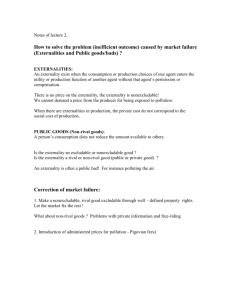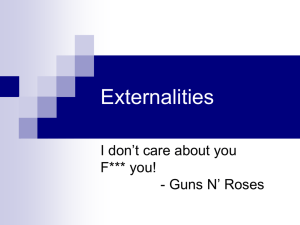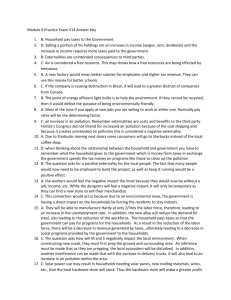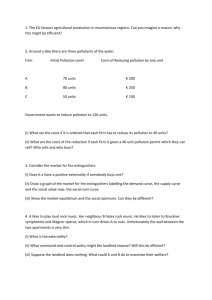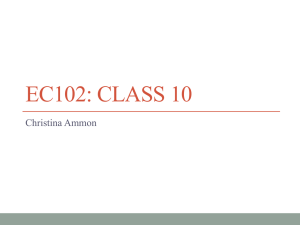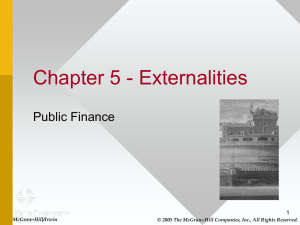File
advertisement
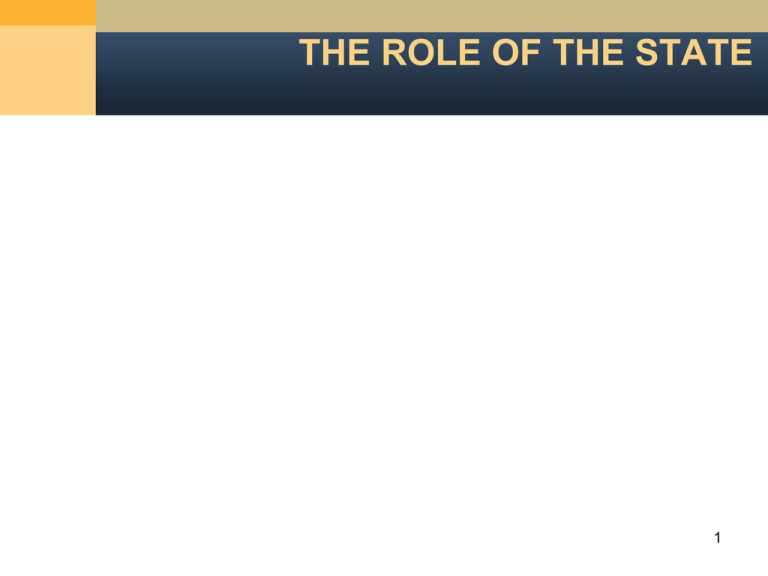
THE ROLE OF THE STATE 1 The role of Government Market failure – the invisible hand pushes in such a way that individual decisions do not lead to socially desirable outcomes A market failure occurs when the market outcome is not the socially efficient outcome. Some action by the government is sometimes necessary to ensure that the market does work well. This topic examines the relationship between business and government, and in particular, the government’s role in influencing business. 2 Government’s Role in Influencing Business 1. 2. 3. 4. 5. 6. 7. 8. 9. 10. Prescribes the rules of the game for business. Purchases business’ products and services. Uses its contracting power to get business to do things it wants. Is a major promoter and subsidizer of business. Is the owner of vast quantities of productive equipment and wealth. Is an architect of economic growth. Is a financier. Is the protector of various interests in society against business exploitation. Directly manages large areas of private business. Is the repository of the social conscience and redistributes resources to meet social objectives. 3 Clash of Ethical Systems Business Beliefs Government Beliefs Individualistic ethic Maximizes concession to Collectivistic ethic Subordinates individual goals self-interest Minimizes the load of obligations society imposes on the individual (personal freedom) Emphasizes inequalities of individuals and self-interest to group goals and group interests Maximizes obligations assumed by the individual and discouraging self-interest Emphasizes equality of individuals Figure 11-1 4 Interaction Among Business, Government, and the Public Lobbying Business • Interest groups • Not buying products • Protests Regulations and Other Forms of Persuasion • • • • • Advertising • Public Relations Government Political Process Voting Interest Groups Contributions • Politicking • Political influence Public Figure 11-2 5 Interaction Among Business, Government, and the Public Government / Business Relationship • Lobbying Public / Government Relationship • Voting • Electing officials Business / Public Relationship • Advertising • Public Relations • Other forms of communication 6 Privatization Privatization The process of “turning over to” the private sector some function that was previously handled by government. 7 Other Nonregulatory Government Influences Major employer Standard setter Largest purchaser Use of Subsidies Transfer payments Major competitor Loans and loan guarantees Taxation Monetary policy Moral suasion 8 Government’s Regulatory Influence on Business Factors to Consider Regarding Government Regulation Fair treatment Protection Scope Cost Burden 9 Reasons for Regulation Controls natural monopolies Controls negative externalities Achieves social goals Controls excess profits Controls excessive competition 10 Types of Regulation EWURA TCAA TCRA 11 Types of Regulation NEMC Occupational Safety and Health Administration TBS 12 Benefits of Regulation Fair treatment of employees Safer working conditions Safer products Cleaner air and water 13 Costs of Regulation Direct costs Indirect costs Induced costs • Effects 1. Innovation may be affected. 2. New investments in plant and equipment may be affected. 3. Small business may be adversely affected. 14 Deregulation Purpose Intended to increase competition with the expected benefits of greater efficiency, lower prices, and enhanced innovation. Dilemma Many competitors are unable to compete with the dominant firms. Must enhance competition without sacrificing applicable social regulations (e.g., health and safety requirements). 15 Externalities An externality is present when the activity of one entity (person or firm) directly affects the welfare of another entity in a way that is outside the market mechanism. • Negative externality: These activities impose damages on others. • Positive externality: These activities benefits on others. 16 Externality If externalities exist, it means that those involved in the demand and supply in the market are not considering all the costs and benefits when making their market decisions. As a result, the market fails to yield optimal results. 17 When there is a negative externality, marginal social cost is greater than marginal private cost. • A steel plant benefits the owner of the plant and the buyers of steel. • The plant’s neighbors are made worse off by the pollution caused by the plant. 18 Examples of Externalities Negative Externalities • • • • • • Pollution Cell phones in a movie theater Congestion on the internet Drinking and driving Student cheating that changes the grade curve The “Club” anti-theft device for automobiles Positive Externalities • • • • • Research & development Vaccinations A neighbor’s nice landscape Students asking good questions in class The “LoJack” anti-theft device for automobiles Not Considered Externalities • • Land prices rising in urban area Known as “pecuniary” externalities 19 Nature of Externalities Arise because there is no market price attached to the activity Can be produced by people or firms Can be positive or negative Public goods are special case • Positive externality’s full effects are felt by everyone in the economy 20 Graphical Analysis: Negative Externalities For simplicity, assume that a steel firm dumps pollution into a river that harms a fishery downstream. Competitive markets, firms maximize profits • Note that steel firm only cares about its own profits, not the fishery’s profits. • Fishery only cares about its profits, not the steel firm’s profits. 21 Graphical Analysis, continued MB = marginal benefit to steel firm MPC = marginal private cost to steel firm MD = marginal damage to fishery MSC = MPC+MD = marginal social cost 22 Pollution Tax One class of solutions to the externality problems involve internalizing the costs and benefits, so that the market can work better. Pollution Tax: if a firm is creating a negative externality in the form of pollution, create a tax on the polluting firm equal to the cost of cleaning up the pollution. Regulation Through Taxation* Marginal social cost Cost Marginal private cost P1 Efficient tax P0 Marginal social benefit 0 Q1 Q0 Quantity Pollution Tax Command Another approach is command—rather than imposing a tax or offering a subsidy, the government simply requires or commands the activity. • For a negative externality like pollution, the government simply requires the company to stop polluting. • For a positive externality, like inoculation, the government requires certain classes of citizens to be inoculated. Marketable Pollution Permits Another approach to pollution is the introduction of marketable pollution permits. • The government sells the permits, which in total allow the amount of pollution that the government believes to be acceptable. • Demanders, typically firms, purchase the permits, allowing them to pollute up to the amount specified by the permits they own. • If a firm is able to employ a cleaner technology, then it can enjoy additional revenues by selling its pollution rights to someone else.


